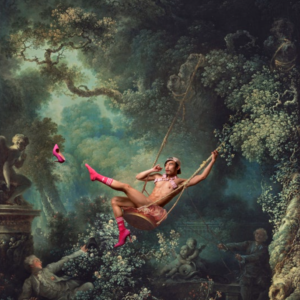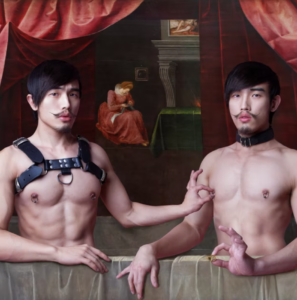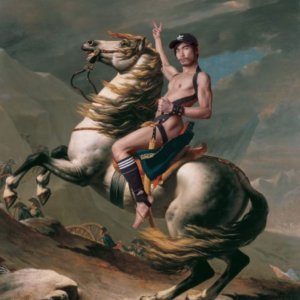To recap where we’ve come from and why this blog series exists - a brief history review and my own thoughts on why NFTs matter:
The Industrial Revolution enabled an increased scale in human organization that facilitated specialization and coordination. Groups of people were brought together in production processes, leading to the rise of commerce and infrastructure types previously hard to imagine. A process ongoing for the last several hundred years, it can be fairly argued that we’re now experiencing a new phase of Industrial Revolution, one that will shape the World in ways we do not yet fully understand.
The first infrastructure developed during the Industrial Revolution was transportation - roads, canals, rail, air - for the movement of people and goods. The second infrastructure developed was energy utilities - oil, pipelines, gas, electricity - for the transmission of power. The third infrastructure has been telecommunications - radio, tv, satellite, Internet - but to what end? Digital Identity. Yielding authority, influence, sovereignty and community, an individual’s digital Identity now has real value, and that digital Identity is best expressed by NFT.
Essential for establishing Identity and authority, NFTs look to be the most likely candidate for spurring increased scale in human organization and bringing together groups of people in the production process. In the space where blockchain meets NFTs we should begin to see new kinds of stores, new habits of time, new work processes, new forms of communication, new kinds of commerce, new ideologies, new forms of play and leisure, new communities. NFTs are the latest versions of the Industrial Revolution’s essentials - technology plus organization.
But what does NFT utility and adoption look like in five years? Ten years? Does NFT utility even matter? Who are the winners in the end? We’ve entered a creativity-based culture, so let’s talk to the creators!
With so many unknowns in this new phase of Industrial Revolution, I’ve taken it upon myself to dig into the minds and projects of important NFT creators and crypto artists. My first goal in doing so is to better clarify to new and potential collectors what the NFT market looks like right now in order to set a benchmark for future comparisons. Next, in dedicating each blog post in this series to a single artist, I’m hoping to bring eyeballs and engagement to the artist interviewed.
These are the interviews in the series so far:
- Chatting With The RektGuy
- The Brand & Business of Guido Di Salle
- The Brand & Business of TylersJourney
- The Brand & Business of Gabriella Morton
- The Brand & Business of Neil Burnell
- The Brand & Business of Dave Krugman
- The Brand & Business of DarkMarkArt
- A Chat With The Regulars
- The Brand & Business of Patrick Amadon
- A Chat With @spz7dsn_graphic of BrickBeads
- The Brand & Business of Cath Simard
- A Brief Chat with Mehdi Nazeri
- The Brand & Business of Steve Walasavage
There’s Only One Yuyu …
Today I’m interviewing Berlin-based multidisciplinary artist and creator YuLiang Liu, also known as Yuyu. Originally from Taiwan, Liu only started discovering his own ways of expression after his relocation to the German capital in 2015. A force of Nature whose personality and energy are obvious in the message and execution of his art, Yuyu creates inseparable connections between artist and collector by appropriating masterpieces of the European Golden Era to create parallel moments in history.
Describing his work as “a hybrid form of art and photography, building unexpected and provocative bridges between styles, media, and eras,” Yuyu says that, through alternative story telling, his creations “establish imaginative realities designed to shake conservative societal structures and to queer art history.”
Without a doubt, “There’s only one Yuyu!”
How do you define web3 and why is Identity important to you?
Not an easy question for a starter. I think we can find plenty of definitions for Web3 depending on one’s point of view. For digital artists, web3 is a land of opportunities that never existed before, for investors web3 is a volatile, yet highly profitable new venture, while for entrepreneurs and activists, web3 is a much more useful tool for fundraising, VC, etc.
My personal view is that Web3 is a much needed and brilliant re-branding of the crypto-niche. Web3 is a culture of community produced value and our Identity within these communities. And of course, Identity becomes ever more important as societies evolve. For myself, Identity has always stood at the very core of my artistic practice. It’s what motivates me to discover my placement in the world.
Identity is what defines our individuality, I am not sure you can put a price on that. That’s why Web3 has become such a pivotal part of my creative career. Even though I had a solid career before NFTs (solo show in SoHo House Berlin, published in a series of magazines and art books, collected by the Tom of Finland Foundation for their permanent collection in Los Angeles, California), never before entering this space have I felt as though I’m part of the art world.
What makes a good NFT experience?
A combination of things make for a good NFT experience. Shared knowledge, community, visionary founders, collective thinking, and profitability are some of the highlights.
What exactly is cryptoart?
Does anyone know yet? This industry is so fresh it’s hard to come up with clear definitions. If I had to define it somehow I would probably make 2 separate distinctions. There’s crypto-art fundamentally connected to the blockchain, meaning the technology becomes part of the artwork itself (artblocks). On the other hand, the majority of art in the space does not fit in this category. For many artists, including myself, crypto-art is a tool - a way to solidify provenance and ownership over our intellectual property.
One thing I can say feeling certain though is that the definition of crypto-art will continue expanding in the following years. I’d love to review this question again in the future.
How are you using technology to realize your artistic vision?
Technology is an integral part of my artistic process. Even though appropriating art and collage have existed long before the vast technological advancements of the past three decades, the level of realism I’m aiming to achieve is impossible without extensive control over an image. Thus, technology comes in very handy in securing a flawless result.
Are there misconceptions about you and/or your art that should be cleared up?
I love this question! Yes, absolutely! Whether it comes from my appropriating expression, my sexuality, or my Asian decent; people often fail to see further than those limiting labels. And of course this does not apply only to myself, but to many other artists as well.
Despite the many opportunities this industry provides, it’s important to keep reminding ourselves how much we lack in the understanding of art history. The space operates mainly through social media and that comes with an extremely short attention span and superficial approaches. Even though the above mentioned elements are parts of my identity and can be seen in my work, they don’t define my work as a whole.
What separates content creation from art is the depth of connection and message the second conveys. As this industry matures culturally, we need to evolve our appreciation of art further than just aesthetics and towards a deeper understanding of its reason of existence. What I would like people to understand about my work is that, at its core, my work exists as a liberating act from an excluding society. Yes, it is sexy and it showcases humour, but that’s because I am too, and I create them. I value my work as significant commentary towards the Western cultural foundations and I want to value my audience as people who understand the conceptuality of my creations.
The most significant challenge I’ve experienced in my NFT art journey comes from the nature of my work in relation to the current market preferences. In a space where the majority of collectors are heterosexual white males, it comes at no-surprise that male nudity is not yet considered mainstream. I’m not saying this with any bitterness - it’s an obstacle I knew existed and am determined to overcome.
What’s your plan to increase eyeballs and sales of your art?
My strategy for increasing sales consists of three main pillars:
- Exposure: Social Media, Exhibitions, Interviews, etc
- Networking
- Validation: Brand partnerships, curatorial essays about my work, etc.
A big part of my strategy for this year is devoted to growing my exposure to new audiences, both in the physical and digital realms. I’m targeting whomever is willing to question discriminatory structures and wants to be part of the change. At the moment I’m in the process of exploring editions as a means of expanding my collectors base with an accessible entry price. At the same time, I’m working on brand partnerships that can be beneficial for my professional growth. I wish I could share more details, but I like some mystery. All I have to say is keep an eye on my moves starting next month!
Artists as a whole could benefit from being a little more business savvy. What are some key actions you took to establish your career?
In this regard I consider myself to be luckier than most. In the years prior to my involvement with NFTs I had collaborated closely with collectives and non-profit cultural organisations. This experience taught me the importance of having solid business structures. It took me months before introducing myself into the space because I was working on creating a consistent, memorable brand that people can relate to. During these months I was able to build both personal and professional relationships with people and brands I admire. Nurturing these relationships led to the validation of my vision, which felt indescribable.
I’m no expert for sure, but I think setting up monthly and yearly objectives apart from the creation process has helped me so far. Marketing is a feared term among artists, but it is as important as the work itself. For me, marketing is always a brand priority and I like to consider everything I release as highly curated drops adding value to my brand’s awareness and evolution.
Unfortunately, unlike the world of PFP's such as Bored Apes and Punks, there isn't a cool factor or social media flex associated with cryptoart NFTs within the community. How can artists resolve this issue?
I have to respectfully disagree. It may not be as easy to flex art as it is with PFP’s, but owning a blue chip artist can be a pretty solid flex within the community. Take as an example the works of Xcopy, Fewocious, FvckRender, Grant Yun, or Tjo among others. Collectors are rallying to grab a piece from what they consider significant.
What is slightly different with art compared to PFPs is that they are harder to liquidate atm. But to be honest I don’t like comparing art to pfp projects. Yes, the underlying technology is similar, but their direction is so different.
What I like to question myself is how do we make art lovers and collectors of the trad world appreciate and value the work we do in this industry? Assuming we had institutionalised validation for crypto art, I bet the flex for OG art would be even bigger than the one for Apes.
I see a lack of traditional NFT-type tokenomics missing from cryptoart collections - there’s no rarity type mechanism for speculators. Do you see cryptoart NFTs going this direction?
I feel speculation in art investments is slightly different than the one in collectible pfp projects. Collectibles come with a business proposal, a roadmap, a team of professionals promising to create value for the holders. The way the minting process is structured takes inspiration from the excitement of gambling and thus, rarity mechanisms are in place to make sure the game is appealing to thousands of people. All those are considered way before creation and launch of each project.
Art on the other hand is expression, it doesn’t always come with a plan of action. Traditionally in art investments, instead of rarity mechanisms, the value comes from a combination of things. Factors such as art critics, curators, gallerists — the so called “gatekeepers”, are there to make sure your investment is solid and the artist will keep rising in value.
It’s hard to say where crypto art is heading. I'm sure in the following years we will see artists exploring all different routes with their work. It’s for sure interesting to see where it takes us.
What’s your view on the NFT market right now?
The market at the moment is undergoing a much needed correction. Even though it’s been tougher for the past couple months (sales wise), I'm very optimistic for the future. I personally know a lot of people working non-stop to deliver value and I'm absolutely bullish on them. I feel, without the constant FOMO affecting our decisions, it has become easier to clarify goals and work restlessly towards achieving them. It sounds cliche, but I think the market right now is building foundations for the next bull run.
What do you wish people were talking about more in the NFT space?
I wish people were talking more about ART. Its history, origins, significance, etc. If we want to legitimatise our bubble as the evolution of the art world, we need to step up our game when it comes to those. A few big collectors alone cannot take us there, it’s up to all of us to educate and discuss those issues more.
What’s the best marketplace for NFT creators? Is this different from the best marketplace for NFT investors?
When it comes to art, I would probably say SuperRare is the best marketplace. They have been pushing the boundaries of digital art perception, have established a healthy base of collectors, and are constantly announcing new implementations that can attract more eyes into the space.
For investors my experience is limited. I would say Opensea seems like a good option due to their massive user base. But again, it depends on what type of investors. Art investors can have great successes even without it.
S.W.O.T ANALYSIS of your business! Strengths? Weaknesses? Opportunities? Threats?
- Strengths: C.U.N.T. (Charisma, Uniqueness, Nerve, Talent)
- Weaknesses: Limited market (too gay)
- Opportunities: Conceptual Photography has yet to establish its significance in the space, Partnerships with well established art platforms exploring the new technologies.
- Threats: Market Volatility, Potential Future Regulations
In closing …
I’d like to close with all the important DYOR links I could find on Yuyu as well as some of my favorite pieces from his portfolio of work.
DYOR Links:
- Twitter - https://twitter.com/cyber_yuyu
- Instagram - https://www.instagram.com/yuliangliubln/
- SuperRare - https://superrare.com/cyber_yuyu
- ShowTime - https://showtime.xyz/@cyberyuyu.eth?list=created
- Foundation - https://foundation.app/@cyber_yuyu
- MakersPlace - https://makersplace.com/cyber_yuyu/
- KnownOrigin - https://knownorigin.io/cyber-yuyu
- Website - https://www.yuliang-liu.com/


